
MAY CONTAIN NUTS

Search Shorpy
SHORPY ART

Framed or unframed, desk size to sofa size, printed by us in Arizona and Alabama since 2007. Explore now.
Join and Share
Ad-Free Shorpy
Shorpy is funded by you. Patreon contributors get an ad-free experience.
Learn more.

Recent comments
- Killed by Amtrak
- Back to the Future
- Heckuva remote control!
- Sometimes — Things Go Bump!
- I SEE THE LIGHT
- Union Switch and Signal Company
- Get That Light Out Of My Eyes
- Eggs. Eggs. Eggs. The Egg Man is Here!
- Foreboding caption
- Famous Hollywood faces
- Not just S&P
- re: Those things in the jar
- Up In Smoke
- Medical Smoking
- Quick fix
- A Quink Comment
- If You’re Like Me, Never
- Delivering the News
- U.S.A.
- S&P
- 1940 Zenith radio model 6G601
- Quality goes in before the name goes on!
- Snazzy skirt
- Carbon Arc Lamps
- Illuminate us
- I remember it well
- I can't prove it
- Complicated then, forgotten now
- Bryan-Stevenson
- Skinny is as skinny does
Member Photos
The Shorpy
Print Emporium
Print Emporium
Search Shorpy
Search results -- 30 results per page
- Hall of Dinosaurs: 1943
- ... at Topeka, Kansas." 4x5 inch Kodachrome transparency by Jack Delano. View full size.
Santa Fe's Topeka Shops This photograph ... Posted by Dave - 05/03/2017 - 8:40pm -
![Hall of Dinosaurs: 1943 One of our first posts from 10 years ago, enlarged and re-restored.
March 1943. "Santa Fe R.R. locomotive shops at Topeka, Kansas." 4x5 inch Kodachrome transparency by Jack Delano. View full size.
Santa Fe's Topeka ShopsThis photograph was taken looking south in the locomotive shop building of the Topeka Shop complex. This building is still in use today, only it is filled with diesel-electric locomotives instead of steam locomotives. If you are acquainted with the Topeka area, this is the building that is just to the west of the Branner St. viaduct.
If you just showed me thisIf you just showed me this picture without any background information, I would swear it was out of a computer game.
[World of Traincraft! - Dave]
I'd play thatLet's be honest, the Jack Delano fans among us would gladly play "World of Traincraft."
All That Fluffy White StuffSee all that fluffy white stuff clinging to the outside of the fireboxes and laying on the floor?
That's asbestos, which was used as "lagging" insulation on many steam locomotive boilers.
'Nough said.
BNSF Topeka ShopsHave a look inside:
More GhostsSurpassed only by Delano's "Locomotive Dreams."
(The Gallery, Kodachromes, Jack Delano, Railroads)](https://www.shorpy.com/files/images/SHORPY-1a34710u1.thumbnail.jpg)
- Maine Train: 1940
- ... in Caribou, Maine." Medium format acetate negative by Jack Delano for the Farm Security Administration. View full size.
The Trains ... Posted by Dave - 11/01/2022 - 12:27pm -
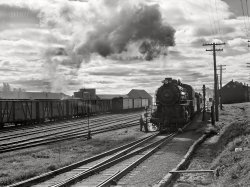
- Agri Culture: 1942
- ... activities among farm people." Acetate negative by Jack Delano for the U.S. Office of Coordinator of Information. View full size. ... Posted by Dave - 01/24/2023 - 4:27pm -
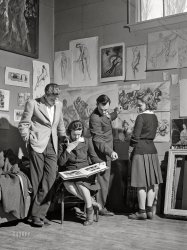
- Polish Jokers: 1940
- Photographer Jack Delano explains that he made the couple laugh by telling Mr. Lyman his ... Posted by Dave - 04/25/2019 - 12:41pm -
![Polish Jokers: 1940 Photographer Jack Delano explains that he made the couple laugh by telling Mr. Lyman his pants were falling down. "The thought of such a catastrophe," Delano writes, "apparently made them break up."
September 1940. "Mr. and Mrs. Andrew Lyman, Polish tobacco farmers near Windsor Locks, Connecticut." Medium format acetate negative by Jack Delano for the Farm Security Administration. View full size.
Lithuanian jokers, actuallyFarther down in the comments section to which Dave links for the laughing-couple tale, I found the following (comment by esagys): "Actually they're both Lithuanians, his name was originally Andrius Limonas, according to his son. She was his second wife, Anna (Ona) Gailiunaite (my grandmother's sister), from Vabalninkas, near Birzai, Lithuania. Both are buried at St. Joseph's Cemetery on Route 75 near Bradley Airport."
[At various times during its history, Lithuania has been been appended to, confederated with or occupied by various larger nation-states, including the Soviet Union, Germany and Poland (e.g., the Polish-Lithuanian Commonwealth). Which is why many erstwhile Lithuanians (especially ethnic Poles) might identify as Polish. - Dave]
Tobacco up northI never knew until I saw the movie "Parrish" when I was about 12 that tobacco was grown north of Kentucky.
Andrew and Anna's headstoneFrom Find a Grave
Saint Josephs Cemetery
Windsor, Hartford County, Connecticut, USA
Connecticut shade-grown tobaccoIn the cigar world, Connecticut is famous for its shade-grown tobacco, in which plants are grown under a thin cloth to exclude direct sun. Shade-grown Connecticut Broadleaf has a distinctive nutty, mellow quality that is all its own.
Other countries, like Ecuador, grow their tobacco on cloud-covered mountains to duplicate the filtered sunlight provided by the gauzy cloth.
It's a wrapAs soon as I saw "Connecticut" I knew this was wrapper tobacco. As in the leaf rolled to make a cigar. Connecticut varieties need shade to prevent sunburn, often grown under light cover.
Shade grown tobacco was common In the middle of the last century, likely before and after also, tobacco was grown under tent-like white sheets of what looked like gauze. The sheets were supported on poles(not Poles) above the growing plants, nearly 10 feet in the air.
I was informed that was 'shade grown tobacco', and was used to form the wrappers for cigars.
Windsor Locks is the locale where Bradley International Airport is located, from which I took my first flight, to NYC.
There was a lot of farm country in that area, with many tobacco growing farms, though I can't say what it looks like now.
tom
Pioneer Valley tobaccoI went to school at UMASS/Amherst in the 70s. The surrounding Connecticut River floodplain used to be full of tobacco fields and sheds. The population has lots of Polish and French last names.
Tobacco Drying Barns1960-70 (my age 5-15 years old) I would accompany my parents as they drove up from southern Connecticut to southern Vermont to visit Grandma. A lot of that time predated the completion of Interstate 91, especially in Massachusetts.
Along the Connecticut River in Northern CT & through MA I remember passing huge fields of tobacco and drying barns.
Here's an article about tobacco in Windsor Locks:
https://connecticuthistory.org/windsor-tobacco-made-in-the-shade/
Best place on Earth in 1940?Whichever nationality was correct, they were among the luckiest members of their tribe to be on the other side of the Atlantic for the dawning epoch!
This is my neck of the woods.I'm in Westfield, Mass. The Connecticut River Valley from Greenfield up near the VT border to New Haven CT when I was growing up was nothing but canopies of white netting. Thousands and thousands of acres of shade tree tobacco for cigar wrappers.
I'm of Polish heritage and my roots are about 10 miles from Lithuania. Grandparents' documents said Poland-Russia. My parents were 1st gen Americans. My dad picked tobacco and my mom worked in the sheds. Women and girls worked the sheds because this tobacco was for cigar wrappers and their hands weren't as callosed as males. The leaves were sown onto hangers that were then set up in the sheds. The sheds used to be everywhere. Many sheds still exist.
When I was a kid I think you could be 14 to work tobacco with your parents permission. I was game. My parents refused. Said it was some of the hottest and dirtiest work you could do. They had worked in factories and that was easier than tobacco. In later years, the farmers would bring in Jamaicans and Puerto Ricans to pick the stuff. Many stayed which is why there's such a large population (especially Puerto Ricans).
Nowadays when they pick it, I've seen a lot of places use conveyor belts that they set up between the rows. You pick it and stick it on the belt instead of carrying it to the end of the netting. The canopies could go on for an easy 800-900 ft if not more without a break.
I'm a Bing user. Search their images for "new england tobacco photos"
A Photo Well-Known to MeThis photo brings back memories for me! When my aunt returned to Maine in 1961 after living several years in our Ohio town, she gave me a book published by Look Magazine entitled Look at America. It was well-crafted coffee table book organized by geographical areas of the U.S. Compiled in the early 1950s, the book included photos from renowned black-and-white photographers of the time. Favorite pictures included the one above, a photo looking down on Harper's Ferry West Virginia from the heights across the river, and one of some kids frolicking in a pond in Maine. There was something familiar and comforting about this particular picture. Perhaps it was because my part of Northwest Ohio had a huge Eastern European population. These people could have been our neighbors...
Connecticut, the Nutmeg StateIt always comes as a surprise to learn that tobacco is the Nutmeg State's number one cash crop, then and now - though nowadays less than then.
As if we needed proof... that the best photos are the spontaneous ones. Jack Delano was a master at his craft.
(The Gallery, Agriculture, Jack Delano, Rural America)](https://www.shorpy.com/files/images/SHORPY-8c03211a.thumbnail.jpg)
- Retarder Tower: 1942
- ... Central Railroad yard." Medium format nitrate negative by Jack Delano for the Office of War Information. View full size.
Fantastic ... Posted by Dave - 06/03/2013 - 9:31pm -
![Retarder Tower: 1942 November 1942. "Chicago, Illinois. South classification yard seen from retarder operators' tower at an Illinois Central Railroad yard." Medium format nitrate negative by Jack Delano for the Office of War Information. View full size.
Fantastic imageI admit I am a railroad "groupie", but this picture is incredible.
Jack Delano may be the Ansel Adams of railroad images.
The ultimateTrain Set.
Not a groupieBut a rail fan like me and many others who love trains, would this be Markham yard on the IC? (IC the train)
Something to considerAs we enjoy these photos, we should give a tip of the hat to the photographers who often risked life and limb to make them. In this Delano photo take a look at the tower off to the left. I've been in such towers, and whether Jack had to climb up a straight ladder or take an outside spiral stair, there are spots with no handhold and the top higher than it appears. Bulky photography equipment in those days would probably have hung from his body by rope as he climbed or pulled up hand over hand by rope - no easy task. Then they had to produce artistic photos and develop them carefully. Devoted people!
[In this case, Delano was shooting 120 roll film, most likely using a camera similar to the one he's shown with here. -tterrace]
The Proviso YardsActually located in west suburban Hillside, Illinois. These yards are 1/2 mile from where I grew up in the 50s and 60s.
I bet you're right, ferrochrr. All the big yards in the "rail hub of the country" begin to look alike!
Proviso?Proviso yard would be C&NW RR, (UP RR today) not the IC, as for climbing up into RR towers, they were not hard to do, sure the stairs could be a little steep, but certainly not difficult to manage. I've been in a few towers myself for photo opportunities as well.
Connection queryCan someone explain how the levers on the control panel were connected to the switches in the distance? Looks to me as if only a few inches of movement on the lever would activate a switch on the rails that must have been relatively large. How was it done? Cables? Motors? Is the same principle used in modern railroading?
LeversTo answer some questions, the levers in this photo were connected to the points by means of electrical connections. Previously they were mechanical, in that the levers pulled a number of point rods that activated the retarders and switch points. Sometime around 1930, IC upgraded their systems to a more modern type that used motors and electrical impulses to activate things. Believe it or not, though largely modernized, a similar system is still in use today.
(Technology, The Gallery, Chicago, Jack Delano, Railroads)](https://www.shorpy.com/files/images/SHORPY_8d23233a.thumbnail.jpg)
- The Dinette: 1941
- ... earlier from above . Medium format acetate negative by Jack Delano for the Farm Security Administration. View full size.
Dinette ... Posted by Dave - 02/04/2019 - 11:36pm -
![The Dinette: 1941 May 1941. "Main street of Childersburg, Alabama." And a close-up of the restaurant glimpsed earlier from above. Medium format acetate negative by Jack Delano for the Farm Security Administration. View full size.
Dinette DelightsI bet I could get a great slice of lemon icebox pie and a sweet tea at the Dinette.
Why So Much Construction?The Delano pictures of Childersburg show a lot of new buildings going up in the main business district of time. The 30s-early 40s was not a time of heavy building in old southern downtowns, unless there is a military base nearby. So I took a look.
A January 1939 tornado had taken a 100 yard swath out of Childersburg's business district.
[The construction had to do with a new Dupont munitions factory. Jack Delano was in Childersburg to document the "boomtown activities" surrounding the construction of the nearby Alabama Army Ammunition Plant: "Photographs show main street. Construction of the town's first motion picture theatre, stores and bunk houses. Tent and trailer camps. Night scenes. Boomtown activities. Men filling in application for employment forms for Dupont Powder Plant. Dairy barn converted into three story bunk house for powder plant workers." - Dave]
Cream and sugarEver since childhood, there haven't been too many two-word combinations that thrill me as much as "coffee shop" ... written or spoken, or even merely thought of, the words bring a tingle. Magical, the delicious aromas and scenes of comfort conjured by those words.
From the same spot today.It is not obvious from the picture but if you move street-view around the corner and look down the block, you'll see the same 2 story building as see in the "Local traffic: 1941" image that shows this corner.
Can anyone tell mehow could those weight machines make enough pennies to even pay for their construction?
["Weight machines"! - Dave]
Dinette for someIn Alabama in 1941, how welcoming the coffee shop was depended a lot on what you looked like.
Do You Weigh What You Should?The penny scale is a 1921 Mills Lollipop Scale, manufactured by the Mills Novelty Co. Chicago, Ill.
(The Gallery, Eateries & Bars, Jack Delano, Small Towns)](https://www.shorpy.com/files/images/SHORPY-8c05756a.thumbnail.jpg)
- Single, Looking to Hook Up: 1943
- ... & Ohio R.R. caboose." 4x5 Kodachrome transparency by Jack Delano for the OWI. View full size.
The Cupola In the days before ... Posted by Dave - 08/05/2012 - 6:37pm -
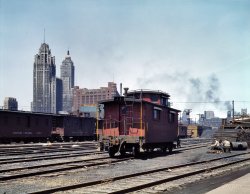
- Super Chief: 1943
- ... takes five minutes." 4x5 Kodachrome transparency by Jack Delano for the OWI. View full size.
Wow This is EXACTLY how I want ... Posted by Dave - 05/03/2017 - 9:32am -
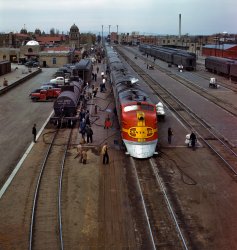
- Dinosaur Garage: 1942
- ... shops at Chicago)." 4x5 Kodachrome transparency by Jack Delano for the Office of War Information. View full size.
Steam Tech ... Posted by Dave - 04/04/2021 - 11:04am -
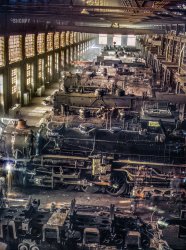
- Second Home: 1943
- ... from division points." Medium format nitrate negative by Jack Delano, Office of War Information. View full size.
"Stormy" ... Posted by Dave - 07/08/2014 - 12:39pm -
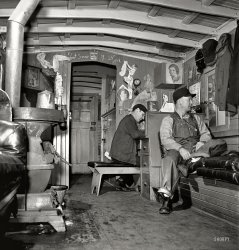
- One Second Fast: 1943
- ... to Pacific time." Medium-format safety negative by Jack Delano. View full size.
Oh....for the Internet I actually ran a ... Posted by Dave - 09/05/2012 - 6:06pm -
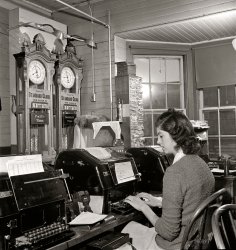
- Aliquippa: 1941
- ... Aliquippa, Pennsylvania." Medium format safety negative by Jack Delano. Office of War Information. View full size.
Times Have Changed ... Posted by Dave - 09/05/2012 - 6:06pm -
![Aliquippa: 1941 January 1941. "Street in Aliquippa, Pennsylvania." Medium format safety negative by Jack Delano. Office of War Information. View full size.
Times Have ChangedAliquippa is the location of the long-closed Jones and Laughlin Steel Company -- presumably seen in the background. On a day off in 1987 I drove through the town and was taken by the sad state of affairs with many vacant homes, large trees growing along the elevated craneways in the steelyard and the once-proud Carnegie Library closed.
Ups and DownsThose hills have to be great for sleds and torture for drivers.
Reminds me of "The Deer Hunter"The streets in these industrial sooty towns in Pennsylvania are very reminiscent of the neighborhoods depicted in that unforgettable movie. I have not been to "Pennsy" since the middle of WW2, but assume it must be more modern and hopefully a lot less dreary today. Anyone? Anyone? Thank you Shorpy for posting these pictures, they are eye-openers for sure.
ReptilianWhat kind of siding is on that darkish building? I've never seen it before.
[Looks like asphalt or asbestos shingles. - Dave]
Pennsyl...eh, whateverStill depressing.
Less drearyI'm a Pennsylvania native, and my state never looked that dreary to me. Then again, I came from the ridge-and-valley part of the state, where agriculture and lumber were the top industries, so I never saw these old coal and steel towns.
AliquippaAliquippa is still pretty dreary and abandoned. I haven't been there for about 5 or 10 years, but I doubt it's changed much.
The city of Pittsburgh, on the other hand, isn't the pollution-filled abandoned hole it was in the 70s and 80s. I grew up there in the 80s, and saw it go through the transformation from a depressed, dirty, abandoned town to a gorgeous city with a great arts center. Older than Yoda, you should certainly go visit if you can and see the gorgeous city it's become!
And yeah, the hills are pretty terrifying. On snow days, we used to go sled riding down some huge hills with pretty steep inclines (I lived in a neighborhood with little traffic.) Good times!
Beautiful ShotSay what you may, but this shot catches the quiet dignity of people capturing the best of what they have. Clean with apparently well maintained homes, they took what they had and tried to elevate it to a better level. Bless them.
Very evocative photoWhat an interesting picture! It almost looks like the person walking down the street is from a more recent time (no fedora, plus his jacket looks like an olive-drab military jacket that people have been wearing for the last 30 or 40 years). It could be Robert De Niro after he just got back from 'Nam!
Truth and BeautyJack Delano was one of the great unsung heroes of photography in the 1930s and '40s. His compositions were impeccable and his images seduced you into the "there" that was there. This is not a depressing photograph.
Home sweet homeI grew up in Aliquippa. When I saw you posting the Pittsburgh and Beaver Falls photos I wondered if you would get to the ones Jack Delano took in Aliquippa. (Aliquippa is a short distance down the Ohio river from Beaver Falls and almost directly across the river from Ambridge, which you've shown in earlier pictures.) I'm pretty sure this is somewhere on Superior Avenue on the hill above downtown. The houses in the middle distance are a neighborhood called Logstown.
Regarding the earlier comment, that is indeed the Jones & Laughlin mill, which closed in about 1986. But Aliquippa never had a Carnegie library. B.F. Jones Memorial Library is on Franklin Avenue and still very much open.
This view probably looks much the same today except that the mill is completely gone, nothing but dirt.
Dreary is as Dreary SeesSay what you will about the so-called dreariness of these photos of the old steel mill towns along the PA rivers, you'll never see the likes of them again in this country again. Where will we get our steel if we ever need it now? My Pastor was born and raised in Aliquippa and still follows his instincts back to his old home during the Holidays. Good for him!
[We'd get our steel here. The United States is the world's No. 3 producer. The industry has shifted from Pennsylvania to the Great Lakes states. - Dave]
Henry Mancini, Aliquippa nativeIn January 1941 Henry Mancini was just months away from graduating from Aliquippa High School (his dad worked in the steel mills there)--and he eventually went on to the Juilliard School and then quite a musical career.
Potential Hot Rods!Look at all that potential Hot Rod Material. Yeah with 350 or 454 Chevy High Performance with 350 Turbo Automatic. Lowered and customized, nice paint job, 21 inch wheels. If only we can go back into time and bring them forward before rust got to them.
Winter is dreary everywhereI lived in a nearby town, Beaver, for a couple of years. This scene probably wouldn't look very different today. The landscape is always dreary on those gray winter days, no matter where you live.
Rough sleddingSledding was great until the ash trucks spread ashes all over our sledding streets. But then Dad could drive all the way home.
AliquippaI live a few miles from where this picture was taken. Aside from the belching steel mill in the background that used the Ohio River as a sewer, it's still pretty much the same.
Streets in my HometownThis is my home town where I was born and raised. Winters looked like this then and now.
This street no longer existsThis street is Irons Hill Road (Iron Street) in the Logstown area of Aliquippa. People in the area will know the area as the "Baker Street" area.
If you look at Google Maps, this street ran up a hill above Baker street. The buildings on the street in this picture were basically abandoned by the early 1980's and they were torn down. The only homes left in the area today are below on Baker Street. The demolition really began when the Highway (route 51) was widened into a four-lane highway in the 1960s.
Lots of hard-working, first generation European immigrants, many blacks who moved from the South, and other hard working people lived in this neighborhood and worked in the massive Jones & Laughlin Steel mill you can see in the distance.
My mother grew up in this neighborhood in the 30s and 40s (and lived on Iron Street). She described it as a safe place where doors were unlocked and people looked out for each other and their children. When we drove through in the 1980s and she saw what it looked like, she was so sad!
Great picture of a past time and place!
(The Gallery, Factories, Jack Delano)](https://www.shorpy.com/files/images/8c04573u.thumbnail.jpg)
- Paging Edward Hopper: 1940
- ... Brockton, Massachusetts. December 1940. Photograph by Jack Delano. View full size. These duplexes must have been fairly grand when ... Posted by Dave - 09/07/2011 - 2:43pm -
![Paging Edward Hopper: 1940 Children in the tenement district, Brockton, Massachusetts. December 1940. Photograph by Jack Delano. View full size. These duplexes must have been fairly grand when they were new, probably around the turn of the century. They look like the house where Granny and Tweety Bird lived. Are they still there?
I'll get it running some dayEver since there have been cars somebody has put them on blocks and abandoned them.
Are you sure that picture isn't a model?Look at the people. They just don't look real. And neither does the car or the big tree limb in front of it all.
They are still there...I can't promise you that these exact ones are still around, but there are many that look just like this in Brockton. Some have been restored, some are still run down.
Sure it isn't a model?The people don't look real. The car looks like a toy, and the tree limb in front of it all is huge.
Tree limb??That's a telephone pole. Click here. Another version is here.
Telephone pole?Actually it is a power pole, there are no telephone lines on it. If you look real close you can see the telephone pole and lines in the back.
ever wonder?Ever wonder what the people's thoughts were at the moment the photo was taken? A. Moore
Re: Sure it isn't a model?I haven't poked around this site a lot, so maybe this info is here somewhere (yeah, yeah, I read the explanation of the Shorpy name) -- but maybe you should explain more background to a lot of these photos from the 30s and 40s.
Of course they're real.
These are by documented, well-known, and legendary photographers. Walker Evans. Lewis Hine. Dorothea Lange. Ben Shahn. Russell Lee. Look them up.
The photos are so detailed because they used large format cameras with honking big negatives.
http://xroads.virginia.edu/~UG97/fsa/welcome.html
Read the book Let Us Now Praise Famous Men. Get a hardcover copy that really shows off Walker Evan's photos.
And keep looking back here for more leads on great documentary photography.
Looks real to me.I'm loving those roofs. The shape is wonderful.
How pretty these homes must have looked when new.
This, and "American Gothic".I don't know if it's of any use, but if you look at the "American Gothic" image (another from this shoot), the number 22 is chalked onto the left door on the porch. Maybe somebody who knows Brockton (Dianne Cantara, where are you?) can track down this locale and tell us what's there now.
FantasticThese houses are fantastic.
Are they duplexes or quads? That's an amazing amount of house for a duplex!
Mansard RoofThere are many examples of this style of house where I live, I grew up in one very similar that had 4 single family homes in it, each of which is now at least 5 apartments. The roof style is a Mansard roof if I'm not mistaken and is fairly common in the Northeastern US and Canada, it stands up well to a heavy snowload.
Mansard RoofThe mansard roofs and style of these houses is called the French Second Empire style. In the last half of the 19th century, it was common to have roofs with dormers. It provided an extra residential floor, but tax assessments did not count the top floor in the market appraisals, so owners were, in effect, adding a floor to the building without being taxed for it. This was explained to me by a historian who recently gave a wonderful two-hour walking tour of houses and mills along the Quinebaug River in Putnam, Connecticut. You can see some interesting information about this at:
http://www.americanlandmarks.com/french.htm
They are there!I grew up in Brockton and those places are still there!
Brockton, Mass.Would anyone please post the address of the location this shot was taken? I am working on a photogray project where I am shooting with a similar vision as Edward Hopper paintings. These Mansard Roof homes would be perfect subject matter at sunrise/sunset.
Oh, please forward the address to my e-mail at sternedwards@aol.com
Thanks In Advance,
Charles Roland
1932 Ford Standard TudorThe car is a 1932 Ford Standard Tudor and the color is Washington Blue. I have one just like it.
Look at the detailsI see details such as the fading wreaths in the windows, the rain downspouts that have a "Y" connectors from the second floor roof to the bay window roofs, then to the next level and then down to the ground; the corbels in the entry way. So many homes had them as trim items and so many are removed today. A lot of architectural character is missing in today's homes.
Is it totally genuine?The power pole looks fake at the base, and its shadow is narrower than the pole itself. And take a look at the shadow of the child in black: different angle. The dog ... oh well ... no shadow at all. Maybe not totally fake, but surely retouched.
[The shadow of the pole would be the same width as its base if you could see where two the came together behind the where the dirt has built up along the pavement. The shadow on the ground next to the kid is cast by whatever he's holding; his own shadow is much smaller, like the dog's. - Dave]
(The Gallery, Brockton, Cars, Trucks, Buses, Dogs, Jack Delano, Kids)](https://www.shorpy.com/files/images/1a33854u_0.thumbnail.jpg)
- Early Boomers: 1940
- ... this 'boom' is over." Medium format acetate negative by Jack Delano for the Farm Security Administration. View full size.
Bath Iron ... Posted by Dave - 10/30/2022 - 5:05pm -
![Early Boomers: 1940 December 1940. "War boom in a New England industrial town. Mr. and Mrs. Leslie Bryant in their trailer about two miles out of Bath, Maine. Mr. Bryant works in the shipyard. They have been living in the trailer for two months. They could not rent in Bath and although a trailer cost them almost as much as a house, Mr. Bryant feels that it is a better investment because they do not know where they will go next in search of work when this 'boom' is over." Medium format acetate negative by Jack Delano for the Farm Security Administration. View full size.
Bath Iron Works - Still ThereBath Iron Works is still one of the largest shipbuilders for the U.S. Navy and one of the largest employers in Maine. As it was in Mr. Bryant's day, shipbuilding remains a boom-and-bust industry.
Those ShoesSo many people have been those same shoes. Young, recently married, dreams and worries in equal amounts, uncertainty ahead.
Love alone is not enough and there are always bits of life drama presenting themselves. But with a bit of luck, Mr. Bryant proves himself useful enough at the Plant that he avoids the draft. Mrs. Bryant manages to also find work, and the two find time to build a family under a permanent roof.
[So they were real heels? - Dave]
Well heeled, let's say.
Wonder what happened to them?Well, the "boom" lasted another four and a half years, but Mr. Bryant might well have been drafted, if he couldn't get an "essential industry" deferment.
That does remind me of the old used trailer my parents got for our summer place, with that thin wood veneer.
Twin beds for newlywedsmay work in a movie or on TV, but is not so great in real life. At the other end of domestic life -- that trailer in a Maine winter during a marital bump-in-the road is not going to provide any get away-from-me space. But they are the Greatest Generation; they will make it work.
Trailer lifeSpeaking of Maine winters, how would they keep the pipes underneath from freezing? And trailers are never insulated all that well, so it would’ve been mighty chilly inside, I’m thinking. As for twin beds, the seating arrangements generally pull into a double bed.
[Insulated pipes. - Dave]
Mr. & Mrs. BLeslie Eugene Bryant (1919-1995) married Ruth M. Barstow (1919-1994) in Maine on June 25, 1938.
In December 1940, Leslie and Ruth were photographed in their home by Jack Delano for the Farm Security Administration.
The Bath city directory for 1942-43 mentioned their move to Portsmouth, New Hampshire.
Leslie was inducted into the Army on September 19, 1944, at Portland. His civilian occupation was machinist. In November 1944, he was admitted to the hospital. Diagnosis: reaction to drugs, vaccines, serums (smallpox vaccine) while in basic training. He was returned to duty.
Leslie and Ruth were living in Escambia County, Florida, in the 1950 Census. Leslie was employed as a machinist at Pensacola Naval Air Station.
They were divorced February 1957 in Huntsville, Alabama.
(The Gallery, Jack Delano, WW2)](https://www.shorpy.com/files/images/SHORPY-8c04095a.thumbnail.jpg)
- Special Agent: 1943
- ... the Illinois Central Railroad." Medium-format negative by Jack Delano for the Office of War Information. View full size.
You guys can ... Posted by Dave - 12/18/2017 - 12:12pm -
![Special Agent: 1943 May 1943. Chicago. "Special agent making his rounds at night at the South Water Street freight terminal of the Illinois Central Railroad." Medium-format negative by Jack Delano for the Office of War Information. View full size.
You guys can be slick...by putting your "Shorpy" logo on that IC reefer in a nearly-matching font.
nice jobGreat job of placing the "Shorpy" in this photo. I'd bet Mr. Delano would've had a chuckle over of it like I did.
Long time exposure plus flashI do believe that this, in a way, is a self portrait. At least, in the style of the Renaissance painters who would include a likeness of themselves as one of the background crowd.
Based on the two bright streaks in the sky, likely planets rather than stars, this appears to be a rather long exposure as would be necessary to get a decent exposure of the buildings while using a moderately small aperture to get adequate depth of field. At some point during the exposure the person in the lower right (Delano probably) manually triggered a flash, lighting the rail cars and leaving themselves as a silhouette. Great technique (except the slight bump to the camera seen as a wiggle in the trails of the planets.
[The caption identifies the person in the lower right. It isn't Delano. -tterrace]
Channeling ShorpyHe would have loved this tribute, God rest his soul. Great choice of type by the way. Nicely done
Detective StoryThe agent's silhouette could very well be the logo of a detective story series, it's such a suggestive image! Wonderful image!
Shorpy RRReally like the Shorpy watermark on the box car.
(The Gallery, Chicago, Jack Delano, Railroads)](https://www.shorpy.com/files/images/SHORPY-8d18292u.thumbnail.jpg)
- Stoplight in Vermont: 1941
- ... corner in Burlington, Vermont." Medium format negative by Jack Delano for the Farm Security Administration. View full size.
Is that ... Posted by Dave - 01/09/2019 - 10:24am -
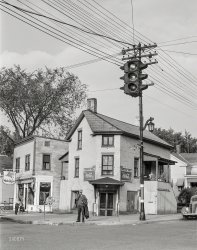
- St. Albans: 1941
- ... the main street in Saint Albans." Acetate negative by Jack Delano for the Farm Security Administration. View full size.
Gone 500 ... Posted by Dave - 11/21/2022 - 5:05pm -
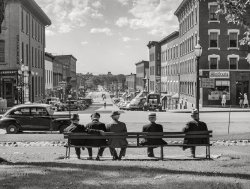
- American Beauty: 1940
- ... to pick potatoes." Medium-format safety negative by Jack Delano for the Farm Security Administration. View full size.
Coals to ... Posted by Dave - 05/01/2021 - 12:51pm -
![American Beauty: 1940 July 1940. "Near Shawboro, North Carolina. Group of Florida migrants on their way to Cranberry [i.e., Cranbury], New Jersey, to pick potatoes." Medium-format safety negative by Jack Delano for the Farm Security Administration. View full size.
Coals to Newcastle...... Potatoes to Cranberry.
Cranberry?Hmm. . . strikes me that they are probably going to Cranbury, NJ - I don't know of any town called Cranberry in NJ. Though we grow a lot of them here!
ShirtsleevesThese people didn't have a lot of clothing, and what they did have was a bit worn down, but really well made. Look at the shirtsleeve on the man to the right. That's not cheap stuff. I wish I could help the young lady fix the front of her dress. And she's got a ring on her finger. Betrothed?
BaldThese people don't look like they can afford tires with rubber on the tread. I imagine they spent a lot of time patching tubes and mounting tires.
Oh, my....A somber photograph, but such a beautiful, beautiful face. This is one of my favorite Shorpy photos ever.
They are also..."Pledged to Drive Safely" on their way to New Jersey to pick potatoes. Obviously, a very hard working family too. License plate toppers like this one are a very valuable collectible in the automobilia market.
Sentimental journeySuch an evocative picture. That beautiful, soulful face. What were her hopes and dreams? And did any of them come true? One of my very favorite Shorpy pictures. It almost makes me cry.
Who are you.My God, so beautiful. Did you know, sweetheart? Did you realize? In the next century, we do.
American Beauty: 1940and the beauty of it all is she could well still be alive. Wouldn't it be a hoot if she posted here?
GorgeousWhat a beautiful young lady. She is still full of hope for the future. I wonder what became of her?
The car1934 Studebaker Dictator, if anyone asks.
I agreeI think the comments reflect my feeling perfectly. It is really a very moving photograph, and she is absolutely beautiful.
Perfect 10The prefix on the license plate indicates the car is from Broward County, probably Fort Lauderdale, Pompano or Oakland Park.
WowThis is just one of those pictures you want to stare at forever. Her beauty is classic.
La GiocondaA "Mona Lisa" smile....
Beautiful GirlI don't think the ring on her finger is an engagement ring. My guess is it's the one pretty thing she had and she put it on the finger which could hold it.
I am curious though--how many of the sharecroppers would have been drafted into the army in another year or so? Did they return to their former lives? Did the women sharecroppers find work in munitions factories?
Blossom DearieThis girl is like a gorgeous rose that has suddenly bloomed in a most unexpected place.
LovelyBut considering the times, destined to look like the older, tired eyed lady in the background.
(The Gallery, Agriculture, Jack Delano, Pretty Girls)](https://www.shorpy.com/files/images/8c35333u1.thumbnail.jpg)
- Film Noir: 1941
- ... Bedford, Massachusetts." Medium-format safety negative by Jack Delano. Office of War Information. View full size.
Listen, Schweetheart ... Posted by Dave - 05/12/2009 - 9:59pm -
![Film Noir: 1941 January 1941. "Foggy night in New Bedford, Massachusetts." Medium-format safety negative by Jack Delano. Office of War Information. View full size.
Listen, Schweetheartyou and me, we're goin' places, see! Let me just light this cigarette, and then ...
Nick DangerIt ain't Los Angeles, but let's see how many Firesign Theatre fans are out there:
He walks again by night. Out of the fog, into the smog. Relentlessly ... ruthlessly ... (I wonder where Ruth is) doggedly ... (rowr rowr rar) toward his weekly meeting with ... the unknown.
Rocky RococoAt Drucker and fourth, he turns right.
At Fourth and Drucker, he turns left.
He cuts across McArthur Park and walks into a big stone building.
(Ouch! my nose!)
Cue Organ MusicBrought to you Loosener's Caster Oil Flakes.
Oh George... George...I'm shakin' the dust of this crummy little town off my feet and I'm gonna see the world. Italy, Greece, the Parthenon, the Colosseum. Then, I'm comin' back here to go to college and see what they know. And then I'm gonna build things. I'm gonna build airfields, I'm gonna build skyscrapers a hundred stories high, I'm gonna build bridges a mile long...
Could it be 1942?The OWI was not created until June of 1942, some six months after the Pearl Harbor attack. If Delano worked for OWI when he took this terrific atmospheric photo, it would have to be in 1942 or later.
[It's 1941. The FSA and RA photos, upon the demise of the Farm Security and Resettlement administrations, were transferred to the Office of War Information, and are credited to the OWI by the Library of Congress. - Dave]
Depth of fieldExposure and depth of field are to perfection for the mood.
If you lived here......you'd be home now!
I Cover the WaterfrontScene: Fleshy woman leaning against lamppost holding unlit cigarette.
Woman: Hi, Sailor.
Sailor: Hi, Mom.
No!!! Put down that pickle!!!I invite all Nick Danger fans to check out "Pat Novak, For Hire" - a short lived 1949 radio series starring Jack Webb, available in all the usual 'net places.
I'm convinced the Firesign boys listened to "Novak" while writing the Nick Danger script, it's a hilarious (intentionally or not) sendup of the hardboiled genre.
Don't touch that dialI see you haven't lost you delicate sense of humor, Nancy! Brought to you by the makers of Loosener's Castor Oil Flakes and Fantastic Cigarettes. Loosener's for the smile of beauty; Fantastics for the smile of success! Tune in again next week -- same time, same station - when Nick Danger meets The Arab!
Nick Danger - I spell my name ...[looks back at office door to check]
...Regnad.
Good Night, LoverHeck, "Pat Novak, For Hire" was a send-up of the hard-boiled genre. If only they'd been sponsored by a certain root-beer maker.
Third Eye"It had been snowing ever since the top of the page, and I had to shake the cornstarch off my mukluks."
SweetI came to slumped over in the front seat of my own car, lying in a pool of cheap rotgut. I had a head full of ideas that were driving me insane, and a mouthful of cotton candy ...
"Ya want some more cotton candy, Danger? It might sober you up!"
You're going down for it sweetheartI think I see Miles Archer's body lying on the sidewalk in the distance.
Oh, you mean Nancy!(Rocky and Nick in dialogue. As we turn up the microphone, Rocky begins...)
Rocky- That tarnished piece of tin is worthless!
Nick- Worthless?! Ha! Not to Melanie Haber!
Melanie Haber?
You may remember her as... Audrey Farber?
Audrey Farber?
Susan Underhill?
Susan Underhill?
How about... Betty Jo Bialowski!
(thinking) Betty Jo Bialowski! I hadn't heard that name since college. Everyone knew her as Nancy. Then it all came rushing back to me like the hot kiss at the end of a wet fist. It was Pig Night at the Oh Mony Padme Sigma House.
*/*/*
Firesign Theatre rocks.
No anchovies? You've got the wrong manJim, if you know for sure that Pat Novak was a parody let me know from where, we've argued about that in our house for years. All I know is that the first time I heard the show, all I could think of was "Gloryosky!! It's the lost adventures of Nick Danger"
Miles Archer?I think it's Floyd Thursby....
Name's Tracer BulletI got eight slugs in me.
One's lead, the rest are bourbon.
(The Gallery, Cars, Trucks, Buses, Jack Delano)](https://www.shorpy.com/files/images/8c04398u.thumbnail.jpg)
- Night Freight: 1943
- ... front of the camera. 4x5 inch Kodachrome transparency by Jack Delano. View full size.
Phantom Number The number 3167 was most ... Posted by Dave - 05/11/2017 - 2:04pm -
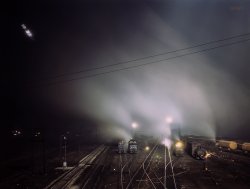
- Pabst Backward: 1943
- ... yard at South Water Street, Chicago." Kodachrome by Jack Delano. View full size.
"Time NOT Forgotten" As though it ... Posted by Dave - 06/14/2017 - 11:51am -
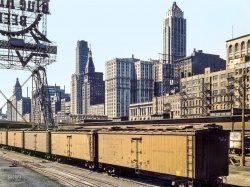
- Jailhouse Rock: 1941
- ... Greene County, Georgia. Medium-format nitrate negative by Jack Delano. View full size. The guitarist, one Shorpy reader points out, is ... Posted by Dave - 08/29/2013 - 9:40am -
![Jailhouse Rock: 1941 May 1941. Music-making in the convict camp at Greene County, Georgia. Medium-format nitrate negative by Jack Delano. View full size. The guitarist, one Shorpy reader points out, is bluesman Buddy Moss.
Cool Hand LukeHe can dance but can he eat 50 eggs?
Great work!I thought you had just downloaded these photos from the L of C website! Now I see that you have worked a lot on every picture, but is it necessary to put Shorpy's signature down in the corner?
[I can see where people might get that impression but there is a lot of slaving over a hot keyboard. I've posted before-and-after pics of some of the photos. The best (biggest) version of the above photo on the LOC site viewable with a Web browser is here. Compare with our full-size version here. I put the site logo on a picture if I think it will be extra-popular and seen elsewhere. Publicity for the site. - Dave]
ScansI'm curious as to how you get such high quality b&w scans. Are you scanning negatives or prints? What kind of equipment are you using?
[Most of the 1930s and 1940s photos I post are extracted from large (20 mb to 190 mb) image files called tiffs, of scans done in the mid-1990s by a Library of Congress subcontractor in Texas. The scans, made using a Sinar 54 overhead camera, are mostly of the original negatives and transparencies. An example of the raw tiff (scaled way down) is on the left below. I adjust the contrast and toning to make the image on the right. - Dave]
Re: ScansThanks for the info, and that's great conversion work you do- I'm currently looking into how I can make high quality b&w negative scans. A Sinar 54 is just a tad out of my price range unfortunately. =)
[A Nikon 9000 ED would not be a bad place to start. - Dave]
About the watermarkAm I correct in saying that the watermark won't be found on any fine art prints I decide to buy once I'm in my new house?
PS. You do good work!
[You are correct. No watermark on the prints. And thanks! - Dave]
The guitarist is Buddy MossThere's another photo from this series on Stefan Grossman's web site: prisondancer.jpg
Thank youThat's an astonishing photograph, thank you for finding and posting it!
[You're welcome. I'm hoping it will make 2008's Top 20. - Dave]
Cool Foot Luke"I'm shakin' it here, Boss!"
Wonderful job of adjusting the contrast and toning, Dave. Thank you.
Night in the BoxEvery man takes his top sheet, puts it on the bottom, then takes his bottom sheet, puts it in the wash. Any man needs to smoke must have his feet over the side. Any man smoking in bed gets a night in the box.
- Carl the Floorwalker
Goober Pea
Car Wash BluesDragline: Anything so innocent and built like that just gotta be named Lucille.
And, of course, Strother Martin's immortal line, "What we've got here is failure to communicate."
Back for a second lookI just wanted to leave a quick comment after having viewed this photograph a couple of times. Dave, I can't tell you how much I appreciate all the time and effort you put in to enhancing these photographs. I've referred a ton of people to this site to take a look at your labors of love. Thanks again, from a very satisfied fan.
By the way, this photo says SO much! Thank you everyone for your comments that have added to the story.
(The Gallery, Jack Delano, Music, Rural America)](https://www.shorpy.com/files/images/8c29075u2.thumbnail.jpg)
- A.S. Gerdee: 1943
- ... View full size. 4x5 Kodachrome transparency by Jack Delano, Office of War Information.
Kodachrome I love these 4x5 ... hope that Dave will keep on posting Kodachrome images by Jack Delano, he is my favourite.
[As long as Jack keeps taking them, I'll ... Posted by Dave - 08/30/2012 - 9:22pm -
![A.S. Gerdee: 1943 April 1943. A.S. Gerdee of 3251 Maypole Street, Chicago, a switchman at the Proviso Yard of the Chicago & North Western Railroad. View full size. 4x5 Kodachrome transparency by Jack Delano, Office of War Information.
KodachromeI love these 4x5 Kodachromes. For the life of me I can't figure out why anyone would shoot anything else (alright, I do really know why but it's still cool stuff). Its such a shame it's not made anymore.
KodachromeI remember shooting a couple of rolls of Kodachrome 25 about 20 or 25 years ago. Absolutely gorgeous results, no perceptible grain, just beautiful. At that time the only people who developed it was Kodak, so you had to send it off in a mailer and in time you'd get your little box of slides back.
KodachromeWell, it is still being made, but only as 64 ISO (ASA) 35 mm film. There are only a few labs left in the world that can process Kodachrome. Also the colour rendition of modern Kodachrome is a bit different from the "classic" emulsion that you see so much of on these pages.
I do hope that Dave will keep on posting Kodachrome images by Jack Delano, he is my favourite.
[As long as Jack keeps taking them, I'll keep posting them! - Dave]
KodachromeThey give us those nice bright colors
They give us the greens of summers
Makes you think all the worlds a sunny day, oh yeah
ImmortalMr. A. S. Gerdee, you have been immortalized, my friend!
C. W. MossNow we know where the mechanic from Bonnie & Clyde ended up.
(The Gallery, Kodachromes, Chicago, Jack Delano, Portraits, Railroads)](https://www.shorpy.com/files/images/1a34669u.thumbnail.jpg)
- Pies in Repose: 1940
- ... Rogerene Quaker living in Ledyard, Connecticut." Photo by Jack Delano for the Farm Security Administration. View full size.
Origin ... Posted by Dave - 11/25/2010 - 7:23pm -
![Pies in Repose: 1940 November 28, 1940. "Pumpkin pies and Thanksgiving dinner at the home of Mr. Timothy Levy Crouch, a Rogerene Quaker living in Ledyard, Connecticut." Photo by Jack Delano for the Farm Security Administration. View full size.
OriginWe finally see where the origin of the fruitcake came from. Could it be the exact same one that my mother had on the table that no one ate in 1950?
The First FruitcakeI remember well the ritual of the long process of making the holiday fruitcakes from cracking nuts (in shells) to chopping candied fruit and dicing dates and finally, after it was all baked for hours, to wrapping it in brandy or rum soaked cheesecloth and storing it away in some cool spot being forbidden to cut into it before Thanksgiving. These rustic pies look and smell (I have a good imagination) incredibly tasty, and the laboriously crafted fruitcake had no idea that in less than 70 years it would become a much maligned and unwanted joke. The elderly in your audience will remember when fruitcake was a highlighted specialty of the holiday season. I understand that now they actually shoot them from cannons and use them for doorstops. As for this photo, I find it outstanding in every way, just beautiful. Thanks yet again for this warm family portrait.
Mmmmm, pieeeeI can smell them!
NeatoI love that wallpaper. I wonder what colour it was.
Ummmm, pie!The pies look delicious. I would be willing to bet those flaky crusts were made with good old lard, too. When you talk of shortening, there wasn't anything shorter than lard.
$5 on the pumpkin pie!I wonder what the folks in this wonderfully American family photo would think if they knew that 70 years later thousands of people were spending their Thanksgiving gambling at a massive casino (Foxwoods) located in the very same town?
It's the kind of wallpaper that's difficult to hangIt's interesting to analyse past family festive gatherings by the relative loudness of the patterns on the wallpaper and curtains in the background.
This kind of wallpaper is annoying to hang to get the patterns to line up.
Could we have a sequence of photos on 'wallpaper and curtain patterns through the ages'? (The 60s and 70s seem to have been particularly loud).
Family albumMore of the Crouches here.
How It Was DoneThe pie in the center front brings back memories of watching my mother finish putting together pies by holding a fork upside down and pressing the tines into the pie's rim all the way around, sealing the top to the bottom and making those tiny grooves.
OmigoodnessI have nothing clever or insightful to say, just want to express my appreciation to Shorpy for showing a slice of life gone forever. We are fortunate indeed to have these photos. The lively wallpaper and cloth speaks to a Quaker way of life I did not know existed--no "plainness" here.
"Just shut it, Tim"The centerpiece lets me pretend it's the Missus sticking the fork in his mouth.
There's something about this pictureThat is just lovely. This is what i like about this site; it reintroduces photographers like John Vachon and Jack Delano.
Reflections on a holidayTaking the photo in the mirror is a great idea.
RogerenesI had never heard of the Rogerene Quakers before, which surprised me, since I am a Quaker and have read quite a bit about Quaker history.
A little googling shows that the Rogerene Quakers had no connection to other Quaker groups, although there was some similarity in their beliefs (particularly pacifism). They also resemble Baptists and Seventh Day Adventists.
I have to say that's a lovely photo, the use of the mirror is terrific. And I would love to have a slice of that fruitcake. I don't know why they have such a bad rep. Like everything, there are good ones and bad ones, and a good one is a real treat.
Compare and contrastInteresting to contrast this family with the one in Kentucky of which we saw so much earlier in the fall. I wonder if their dessert table ever looked liked this?
The pies at my daughter's house yesterday looked just like these--courtesy of my ex-wife.
Makes me feel guiltyI only baked two pies yesterday! I wonder what kind the two-crust pies were; apple, cherry, mincemeat?
This also reminds me of a certain fruitcake my mother baked in 1967. It was kept in our extra fridge, in the utility closet. That was also where my dad's huge liquor collection resided. Mom was soaking it with bourbon every once in a while, and so was I. By Christmas that was some wonderful fruit cake! It had a lovely bourbon flavor, but didn't taste like alcohol.
I hate hearing all of the maligning of fruitcakes that takes place, now! It was just like everything else; bad ones were awful, but good ones were delicious. I would bet the one in this picture was delicious!
I like fruitcakeWe don't see very many people in this mirror view, but the impression is that there aren't that many. After all, the stove in a previous picture wasn't cooking cauldrons. So, six pies (at least), and a fruitcake? Wow. Those home-made pies were probably great, but still seems like a lot of pie.
On the Wallpaper-Mr. Plate looks sad.
Now THISis Pie Town!
The wallpaperThe wallpaper really got my attention. The house we rented from 1958-63 had a very similar print washable wallpaper in our kitchen. Given that this photo was taken in 1940, then our wallpaper might have been 20 years old (or older) at the time.
FROOTSCAKES!Let me at that fruitcake, man. Om nom nom nom nom!
No punsAbout the large family of the rogerin' Quakers? Good, because that would be rude and tasteless.
Thanksgiving 1940Thanksgiving day 1940 was November 21st, not November 28th!
[It was celebrated on two different dates that year, as well as 1939 and 1941. The New England states observed the traditional fourth Thursday in November. - Dave]
Cookery I can't speak for these dear people, but my family always coded two crust pies differently. The slits and occasional decorations on top denoted the contents. I would guess, a pumpkin, sweet potato, cherry, apple and peach. While that glorious molasses and candied fruit and nut bundt would wait for evening coffee and tea, foolishly ignored by the unsophisticated children, in favor of the sweeter and juicier fruit offerings.
FruitcakeI never liked it until I ate my mother in law's. Now, our family demands I make it every year. Usually made two at a time to begin with so one will be ready for the next year. Then every year after, one is made and stored away while the previous year's is eaten. I have to say it is the best I've ever eaten and my family agrees. Even the kids like it. Love to see pictures like this. Brings back memories of my childhood. My mother wore her hair like that and our family Thanksgiving and Christmas dinners were enormous. Lots and lots of people and food. So many, we had to eat in shifts. Such happy memories.
The Timothy Levi Crouch familyThis pictures, along with several others, were taken at my great-grandparents' Thanksgiving dinner in 1940. My grandfather, one of their sons-in-law, is the gentleman with the fork in his mouth. This collection of pictures by Jack Delano is really neat, and I love to see them posted on the internet.
There were 14 Crouch children living at the time this was taken, the youngest being about 12. There were definitely more people at the dinner than this picture would indicate, and most likely some of the other married children dropped in later in the day to enjoy pie.
For many years the family only knew of this one picture. It wasn't until the age of internet that we discovered that there were about 20 of them along with pictures taken at the one-room schoolhouse. My mother is in pictures at both locations. She remembers the photographer being at the dinner, but she doesn't recall him being at the school. It was quite the shock when I showed her all the pictures!
(The Gallery, Jack Delano, Thanksgiving)](https://www.shorpy.com/files/images/8c04161u.thumbnail.jpg)
- Proviso Perspective: 1943
- ... Proviso yard, Chicago." Kodachrome transparency by Jack Delano for the Office of War Information. View full size.
If you listen ... Posted by Dave - 06/28/2022 - 4:50pm -
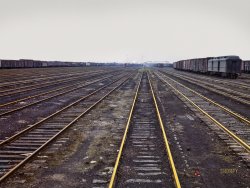
- American Gothic: 1940
- ... of gutters and downspouts. Kodachrome transparency by Jack Delano. View full size.
American Gothic hard working people doing ... Posted by Dave - 05/05/2017 - 4:02pm -
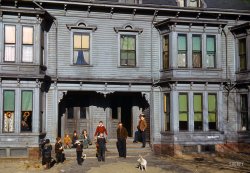
- Home Depot: 1940
- ... store, Brockton, Mass." 35mm Kodachrome transparency by Jack Delano. View full size. As of 2007, Saba Mechanical Plumbing & Heating ... Posted by Dave - 07/21/2012 - 10:32pm -
![Home Depot: 1940 December 1940. "Secondhand plumbing store, Brockton, Mass." 35mm Kodachrome transparency by Jack Delano. View full size. As of 2007, Saba Mechanical Plumbing & Heating is still in business in Brockton, at an address on Linus Avenue.
Hmmm!Even in 1940 people couldn't figure out the difference between You're and Your.
This is building is not on Linus StreetIf this is the same company that is still in business, they have definitely moved locations. This building is too old to be on Linus Street, which is in a "newer" section of Brockton. This photograph must have been taken downtown.
[You are correct, the satellite photos of the current address show a newish house. Even back in 1940 this one was getting nibbled at by the road, and had lost the upstairs porch roof. My guess is it is long gone. — Dave]
The Wily ApostropheHeh. I noticed that too.
Definitely Not GoneAh!
This house is (a) not in Brockton, and (b) not gone!
It's in Somerville, MA (or maybe on the edge of Somerville and Cambridge). It's on the bus route that I used to take from work to home. It's *still* got all the radiators and junk sitting outside of it, 60+ years later -- that's how I recognized it.
Not GoneAmazing! If you could send a photo or GPS coordinates that would be super. I was looking for it on Google Earth but in the wrong place! BIG THANKS.
Definitely.A photo will be taken, and I'll send it along when I have it.
photo of current building RE: DefinitelyCan an url for for a current photo be posted here?
Possibly Gone.I'm the author of the 'Definitely Not Gone' comment. A friend tells me that I might be wrong about that -- it might not be (oddly enough) the same house.
So when I get a chance to take a photo, I'll pass it along, right or wrong. But maybe I shouldn't have been so certain in the first place.
RE:This building is not on Linus StreetI left that original comment, but I would not be surprised if this building is still standing. Most of downtown Brockton still has all the old buildings. I am going back there in a few weeks and will try and track it down. I will let you know if I find it, and take pictures for you.
Smart advertising for theSmart advertising for the 40's.
Very funnyI thought that, too.
(The Gallery, Brockton, Jack Delano, Stores & Markets)](https://www.shorpy.com/files/images/1a33851u_0.thumbnail.jpg)
- Santa Fe Diesel: 1943
- ... Kansas. View full size. 4x5 Kodachrome transparency by Jack Delano.
Great for railfans! What a great photo for railfans!
Santa ... Posted by Dave - 07/17/2012 - 10:08pm -
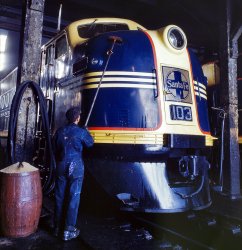
- Steeling Home: 1941
- ... Pennsylvania." Medium format acetate negative by Jack Delano for the Farm Security Administration. View full size.
The rest ... Posted by Dave - 04/04/2022 - 5:30pm -
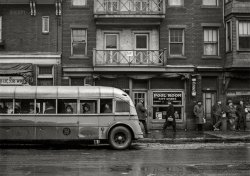
- Squeaky Clean: 1943
- ... the flute after he has taken a shower." Photograph by Jack Delano for the Office of War Information. View full size.
Wonder if he ... Posted by Dave - 07/27/2012 - 1:49pm -
![Squeaky Clean: 1943 July 1943. "Greenville, South Carolina. Air Service Command. A scene in one of the barracks. Enlisted man playing the flute after he has taken a shower." Photograph by Jack Delano for the Office of War Information. View full size.
Wonder if he is thinking aboutthe lady in the photo "Nighthawk - 1943"
I love this site!
Home I grew up a mile from the old air base. It was turned into an industrial park in the 1960's and has been called Donaldson Center ever since. Some of the companies on the base are Michelin Tire, 3M, Lockheed and I worked in the old Procter and Gamble plant there. My family moved to Greenville in the early 60's after the base closed and houses were very cheap.
Precarious Towel PlacementWell. Well. Well! A little beefcake to counter all the cheesecake we've seen on Shorpy.
On behalf of us woman folk who truly ah-dore Shorpy, thank you Dave for satisfying all us ladies once again.
[It's exhausting work. Got a light? - Dave]
KeylessLooks like he's playing a fife. Might even have a "cheater pipe" on it.
Sometimes a fluteis just a flute.
Why hello there handsome rogueI wonder if he survived the war.
Donaldson Air Force Base This was probably taken in one of the barracks at Donaldson Air Force Base. Bomber crews trained there. The runways and many of the buildings are still standing, including some of the old barracks, and some are even used today. Lockheed Martin has an aircraft repair facility out there, and the big planes still take off and land.
Gasp!ooh la la
JimmyThis reminds me so much of that famous image from "East of Eden" where James Dean is sitting shirtless on the bed, playing the recorder.
Charms to soothe the savage breastGiven the setting — an un-air-conditioned South Carolina barracks in the middle of July — his serenity is pretty remarkable. No tweetled arpeggio could soothe ME.
In addition to a flute, he's got peanuts, white petroleum jelly, and a fly swatter. Can anyone identify the tall bottle and the striped jar on the left?
[The one with the stripes is Mennen talcum powder. - Dave]
NutsThat can of Planters looks like it was purchased yesterday. Nice to see some things never change.
Mr. PeanutInteresting use of the newspaper as a bath mat.
Interesting also is the Planter's can at right -- before plastic lids. It appears that it was one of those key-open cans which, while you could reclose it (provided you didn't bend the can or the lid too much), almost certainly left a pair of sharp steel lips which could give ya a nasty salty cut if ya weren't careful.
About 14 years later, my dad was stationed at this same location after it was renamed Donaldson AFB. It's where he met my mom in between the nightly boredom of guarding the flight line.
Forget it girlsThis guy's married, check out the ring. Or maybe that makes him more appealing
ZamfirIf the Master of the Pan Flute looked this good, I'd consider becoming a Zamfir Groupie.
He doesn't and I won't. All flutists are not made alike.
Don't AskI wore a gold band in Basic. Kept the girls from bothering me and the guys from asking too many questions.
That cotlooks really uncomfortable to sleep on. Do they still use cots like that? I guess I imagined they would have metal bed frames with springs below a mattress made from blue and white ticking. That cot looks like you'd have a backache from the sway of it.
But I love the leg, and exposed thigh. Very suggestive. With the flute, and reclining, he's rather like Pan.
Rolls His OwnIn front of the striped Mennen talcum powder is a pouch of cigarette tobacco and, probably, rolling papers.
WindowsThose are some interesting window fixtures. Cheap and simple solutions for cheap and simple structures, I presume.
Another rakeDon't forget to add this one to the new Handsome Rakes category!
[Not really new, but will do. - Dave]
The TooterThat's not a flute, you fools! It's a piccolo.
Neither flute nor piccoloIt's not a flute or a piccolo, it's a fife!
(The Gallery, Handsome Rakes, Jack Delano, WW2)](https://www.shorpy.com/files/images/8d32042u1.thumbnail.jpg)























